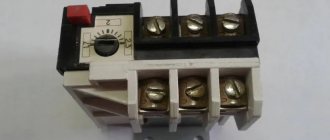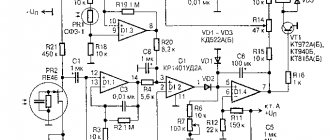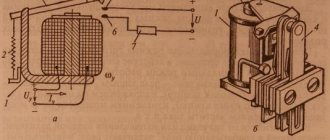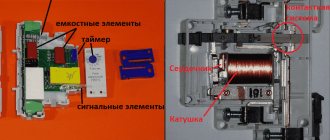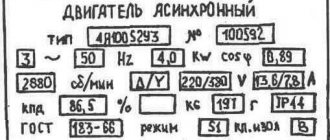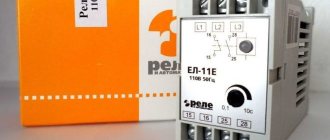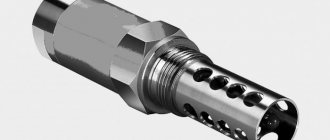Principle of operation
Unlike switching electromagnetic devices, a reed switch has contacts that are located in a sealed flask from which air has been evacuated or filled with inert gas. This design eliminates the process of surface corrosion.
The bulb is not an obstacle for the magnetic field to act on the contacts if they are made of magnetic materials. The reed switch is controlled by the interaction of the contacts with the external magnetic field of a permanent magnet or the electromagnetic field created by the electric current of the solenoid. They are triggered when the magnetic field reaches a certain value.
In addition to magnetic properties, the contacts must have elastic mechanics, since the operation of the relay is associated with their return to their original position after the end of the signal.
Description and purpose
A reed switch is an electromechanical type device that opens or closes electrical contacts. This occurs due to the magnetic contact field generated by the electromagnet. A permanent magnet can also do this.
Reed switch is translated as sealed contact. This is due to its design. Its components are ferromagnetic plates, which are sealed in a glass capsule. It is filled with inert gas, along with two output contacts.
Thanks to the shell, the impact of external factors is minimized, while the device can function normally.
The flask may contain dried air, nitrogen and any other inert gas. In addition, it can be pumped out to create a vacuum. This is done to increase the level of switching voltage.
Reed switch sensors are used in various systems and devices:
- Household meters.
- Keyboards in industrial equipment and synthesizers. The occurrence of a spark from them is excluded. That is why they are widely used in the production of explosive things (where there are dusty fumes or flammable substances).
- Equipment for medical institutions.
- Systems that protect and control the situation, operating on an automatic principle.
- Telecommunication systems.
For security systems, devices made from a magnet and a reed switch are relevant. They signal the closing and opening of doors.
It is worth noting that reed relays are common, which consist of a wire winding and a contact sensor. Such a system has significant advantages: moisture resistance, easy use, no moving parts.
Reed switches are used to protect electrical installations from overloads.
Purpose, areas of application
Semiconductor devices (Hall sensors) are increasingly used in switching electronic devices. However, the reed switches of some devices can withstand competition with them, despite the lag in technical parameters:
- connections hidden by the surface of the bulb guarantee safe operation in explosive areas;
- in devices operating under water, in places with a humid climate;
- in alarm systems based on position control;
- determining the elevator position at the current moment;
- keyboard of industrial devices for reliable and long-term operation;
- some samples of television and radio equipment, medical devices and other areas of technology.
Varieties
Devices are classified into the following groups.
By the nature of the action
- Normally open contact. Under the influence of a magnetic field of a certain strength, the contacts close and current flows through the circuit. After the end of the action, elastic forces return them to their place.
- Normally closed contact. The external magnetic field must generate such a tension that the resulting repulsive force overcomes the elasticity of the contact pair.
- Switchable contacts. The option has three contacts for connection: two are made of magnetic material, and one is non-magnetic. The first two are mutually attracted and commute one of the electrical circuits. In the absence of magnetic fields, the magnetic contacts (one of them) switch to non-magnetic ones and the circuit is re-switched.
By type of design
- Dry. This is a reed switch with a vacuum flask and contacts located in an environment of inert gases. When closing, contact bounce cannot be excluded (uncontrolled presence or absence of contact of their elastic working surfaces).
- Wet. In such devices, a drop of liquid metal, mercury, is added to the contacts. During elastic vibrations during contact closure, it fills the space between them and does not allow the electrical circuit to break.
Operating principle
The operating principle of a reed switch is similar to a switch. The relay consists of a pair of conductive cores with a gap between them. They are hermetically sealed in a glass flask with an inert environment, eliminating the oxidation process.
A control winding powered by direct current is placed around the bulb. When power is applied, the winding generates a magnetic field that acts on the cores and causes the contacts to close together.
When the coil is disconnected from the power supply, the magnetic flux disappears and the contacts are opened by springs. Reliability is ensured by the absence of friction between the contacts, which, in turn, act as a conductor, spring and magnetic circuit.
A special feature of the reed switch sensor is that no forces act on the relay springs at rest. This allows them to make contact in a fraction of a second.
Specifications
To select the required reed switch, you should study its parameters. The main ones will be the following.
- Field strength or magnetomotive force of actuation (V av.) and release (V op.) - provides information about the value at which the contacts close and open. Units of measurement are amperes.
- The speed of action is determined by the response time (T av.) and the release time (T dep.). Measured in milliseconds. Indirectly, the performance is affected by the contact capacitance, which is determined only in the open state and depends on the gap and dimensions of the plates. The larger it is, the more noticeable the inertia of the reed switch in operation. It is clear that small reed switches have better performance than large ones.
- The maximum number of switching cycles (N max) determines the service life of the contacts until they are completely worn out. Measured in billions of operations.
- The permissible frequency range of the vibration level, above which the bulb of the reed switch may burst or the contacts will cease to function normally. Measured in hertz (Hz).
- Maximum power (P max) at which the contacts do not lose their magnetic properties. Depends on the properties of the materials and the dimensions of the contact cross-section. The larger the size, the greater the maximum power. Measured in Watts (W) or kW.
- The breakdown voltage indicates (usually in kVolts) the magnitude at which an arc is formed in the space between the contacts. In another way, this voltage is called the electrical strength of the reed switch. It is determined by the depth of vacuum or the degree of purification of the protective gas, the format of the gap and the materials used.
Checking the functionality of the reed switch
Before installing a reed sensor into a working circuit, it should be tested. In a complex circuit, to get to the cause of the malfunction, you will have to double-check many other potentially defective elements. This is very easy to do if you have a multimeter - you just need to set its dial to the “continuity” position and connect the probes to the terminals. How to connect is shown in the image:
In the non-working position, with the contacts of the reed switch normally open, the multimeter will indicate a break. By creating a magnetic field that makes the connection complete (can be done using a permanent magnet found in some device circuits), the multimeter should show almost zero resistance. Such a reed switch can be used in work.
Reed switch - designation on the diagram
The difference between a magnetically controlled connection in electrical circuits and other types of contacts is the presence of a circle in the image as a symbol of a sealed housing. The specific affiliation to a circuit element is indicated in the form of a set of letters and numbers:
- K1.1 - indicates that it belongs to the relay circuit with which the reed switch works (according to regulatory documents from the times of the USSR, in diagrams and technical literature the reed switch is designated by the letter “K”);
- SF—Denotes permanent magnet control of the reed switch.
There are no strict rules for marking reed switches. The manufacturer puts his factory designation on the body.
Advantages and disadvantages
For comparison, let's take electromagnetic relays with coils and a core. In addition, here are some common positive and negative qualities.
pros
- The dimensions of reed switches are much smaller due to the lack of mechanics for moving the contacts and the core itself.
- Most technical characteristics, such as dielectric strength and breakdown voltage, are several orders of magnitude higher than those of electromagnetic relays.
- The performance of reed switches significantly exceeds that of conventional relays.
- During operation, there is no noise characteristic of the operation of electromagnetic relays.
- The service life of reed switches is many times greater than the service life of electromagnetic relays.
- Reed switches do not require matching to the type of load.
- To control an electromagnetic relay, electricity is required; reed switch devices can be controlled without using it.
Minuses
- The switched load has low power ratings.
- The flask contains a small number of contacts.
- In a dry reed switch, the closing process is accompanied by contact chatter. Wet reed switches are free from this technical phenomenon.
- The reed switch is large in size for compact modern electronic circuits.
- The glass bulb is not strong enough and can be destroyed by vibration phenomena that occur when equipment operates with reed switch devices.
- A protective shield is required to eliminate the influence of external magnetic fields on the normal functioning of the reed switch.
Advantages
Reed sensors have the following advantages:
- Complete tightness allows them to be used in fire hazardous areas and aggressive environments.
- Instantaneous operation allows them to be used in devices with high switching frequencies.
- Elimination of contact bounce for mercury sensors. They are used in equipment with increased requirements for signal purity.
- Small dimensions from 4 mm, simple design, low manufacturing cost.
- High functionality and versatility of the relay.
- Ability to switch low-power signals.
- Large operating temperature range - from -55 to + 110 ºC.
- High strength cores.
- No friction surfaces.
High versatility, reliability and price continue to allow reed switches to compete with direct competitors.
Recommendations for use
During installation and further operation of reed switches, the following factors should be taken into account:
- in addition to the presence of extraneous magnetic fields, when installing reed switch devices, sources of ultrasound should be avoided - it has a negative effect on electrical parameters, changing them;
- reed switch devices do not perceive shock loads, since this may cause the seal to be broken, which will lead to leakage of protective gas or disruption of the vacuum environment;
- the technology for soldering reed switch devices has its own peculiarities; you should strictly follow the soldering instructions from the manufacturer;
- The temperature range at which the reed switch can operate with a guarantee of the declared characteristics has the following average values: from −60 °C to +120 °C.
Reed switches are often used by home craftsmen to make simple alarm and automation circuits for controlling lights on/off. You can see one example of connecting a reed switch in the image below.
How to connect the sensor
If we talk about how to connect a reed switch, then we should start with the installation methods. There are only two fastenings:
- hidden;
- external
It is also worth taking into account the characteristics of the surface where the installation will be carried out, therefore there are two “bases” for connection:
- steel;
- magnetically passive.
So, the part of the relay that is responsible for the magnetic field is fixed to the moving part of the structure. The reed switch must be installed where the moving element departs. What happens is something like this: the moving part is adjacent to the stationary part, producing a magnetic field in parallel and closing the circuit. If the coil, thanks to which the field operates, does not have any effect, then an open circuit occurs and the corresponding program will report a violation. It's quite simple, because this is actually how door sensors in smart homes work.
Installation Features
The nuances that need to be taken into account when connecting a reed switch include:
- Use in places where there is or may be ultrasound is not recommended, because it can confuse the sensor and its settings.
- If there is another source of magnetic field nearby, it must be excluded.
- Do not subject the flask to impacts, as its deformation leads to the unusability of the cores.
And a little about how to check the reed switch: first of all, you need to set up the program, then check the functionality and attach the still loose elements to each other. Afterwards, you can disconnect them and watch the reaction of the program that is responsible for notifications. If everything is normal, we attach the sensors to the right place.


